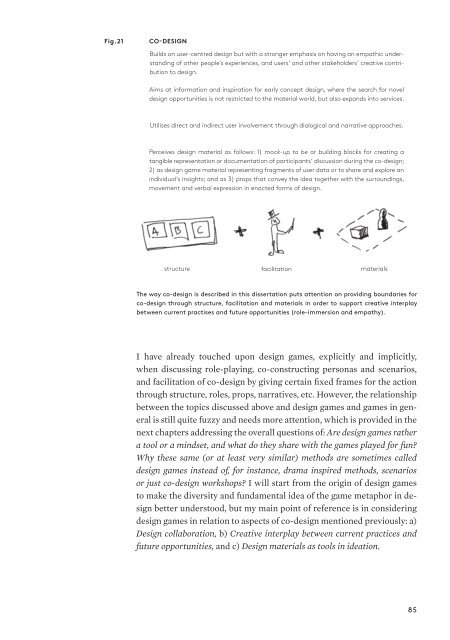Design games as a tool, a mindset and a structure Kirsikka Vaajakallio
Design games as a tool, a mindset and a structure Kirsikka Vaajakallio
Design games as a tool, a mindset and a structure Kirsikka Vaajakallio
You also want an ePaper? Increase the reach of your titles
YUMPU automatically turns print PDFs into web optimized ePapers that Google loves.
Fig.21<br />
Co-design<br />
Builds on user-centred design but with a stronger emph<strong>as</strong>is on having an empathic underst<strong>and</strong>ing<br />
of other people’s experiences, <strong>and</strong> users’ <strong>and</strong> other stakeholders’ creative contribution<br />
to design.<br />
Aims at information <strong>and</strong> inspiration for early concept design, where the search for novel<br />
design opportunities is not restricted to the material world, but also exp<strong>and</strong>s into services.<br />
Utilises direct <strong>and</strong> indirect user involvement through dialogical <strong>and</strong> narrative approaches.<br />
Perceives design material <strong>as</strong> follows: 1) mock-up to be or building blocks for creating a<br />
tangible representation or documentation of participants’ discussion during the co-design;<br />
2) <strong>as</strong> design game material representing fragments of user data or to share <strong>and</strong> explore an<br />
individual’s insights; <strong>and</strong> <strong>as</strong> 3) props that convey the idea together with the surroundings,<br />
movement <strong>and</strong> verbal expression in enacted forms of design.<br />
<strong>structure</strong> facilitation materials<br />
The way co-design is described in this dissertation puts attention on providing boundaries for<br />
co-design through <strong>structure</strong>, facilitation <strong>and</strong> materials in order to support creative interplay<br />
between current practises <strong>and</strong> future opportunities (role-immersion <strong>and</strong> empathy).<br />
I have already touched upon design <strong>games</strong>, explicitly <strong>and</strong> implicitly,<br />
when discussing role-playing, co-constructing person<strong>as</strong> <strong>and</strong> scenarios,<br />
<strong>and</strong> facilitation of co-design by giving certain fixed frames for the action<br />
through <strong>structure</strong>, roles, props, narratives, etc. However, the relationship<br />
between the topics discussed above <strong>and</strong> design <strong>games</strong> <strong>and</strong> <strong>games</strong> in general<br />
is still quite fuzzy <strong>and</strong> needs more attention, which is provided in the<br />
next chapters addressing the overall questions of: Are design <strong>games</strong> rather<br />
a <strong>tool</strong> or a <strong>mindset</strong>, <strong>and</strong> what do they share with the <strong>games</strong> played for fun?<br />
Why these same (or at le<strong>as</strong>t very similar) methods are sometimes called<br />
design <strong>games</strong> instead of, for instance, drama inspired methods, scenarios<br />
or just co-design workshops? I will start from the origin of design <strong>games</strong><br />
to make the diversity <strong>and</strong> fundamental idea of the game metaphor in design<br />
better understood, but my main point of reference is in considering<br />
design <strong>games</strong> in relation to <strong>as</strong>pects of co-design mentioned previously: a)<br />
<strong>Design</strong> collaboration, b) Creative interplay between current practices <strong>and</strong><br />
future opportunities, <strong>and</strong> c) <strong>Design</strong> materials <strong>as</strong> <strong>tool</strong>s in ideation.<br />
85
















